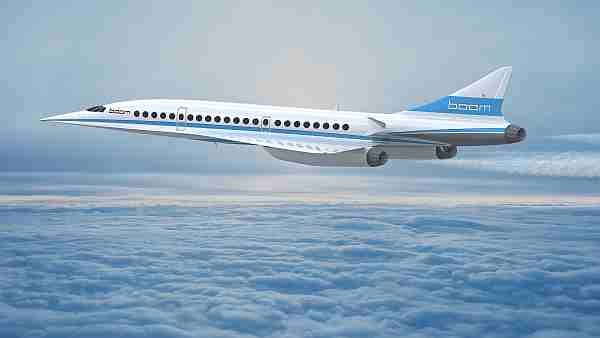Is supersonic flight making a comeback?
Boom Technology (Denver, CO, US), a 2014 start-up aircraft developer, is in the process of building the XB-1, a flying 1/3-scale demonstrator of its supersonic (faster than sound) commercial aircraft.

A new supersonic passenger aircraft is being developed in Denver, CO, US.
Boom Technology (Denver, CO, US), a 2014 start-up aircraft developer, is in the process of building the XB-1, a flying 1/3-scale demonstrator of its supersonic (faster than sound) commercial aircraft. A mockup of the demonstrator was recently on display at the company’s hangar at Centennial Airport near Denver. XB-1 is intended to demonstrate in flight the key technologies for practical supersonic travel, says the company.
Boom Technology’s founder is CEO Blake Scholl, a pilot with a background at Amazon and the founder of Kima Labs. Co-founder and chief engineer is Joe Wilding, who has played leadership roles on multiple aircraft certification programs, including the Adam A700 light jet. Co-founder and chief technology officer Josh Krall, with a background in physics simulation, has developed multi-disciplinary optimization algorithms and design software for the program. At the November open house, the three described the ideas behind the endeavor.
They believe they have a viable business case for the airlines, one that bests the previous longest-flying supersonic transport, the Concorde, jointly developed and built by Aerospatiale and British Aircraft Corp. (BAC) and ultimately retired in 2003. A typical round-trip ticket on the Concorde cost about $20,000 and fuel burn was 6,800 gallons per hour, but the trip between New York and London took about 3.5 hours; the Concorde was retired due to declining sales and rising costs, an accident and the overall post-9/11-caused aviation downturn. According to Boom, their 45-seat jet will be 2.6 times faster than conventional passenger jets, yet cost flyers about $5000 per seat, round trip, in line with today’s business class tickets. Bulky lay-flat seats aren’t needed, since overwater flights will take less than half the time of current flights (thus, little to no jet lag). The group’s preliminary design goal is a speed of Mach 2.2 (faster than the Concorde’s Mach 2) with a 9,000 nautical mile range. Sir Richard Branson of Virgin has already publicized his intention to buy 10 of the craft. The company has an impressive Advisory Board, including Frank Cappuccio, former executive vice president and general manager of Lockheed Martin Skunk Works, Tom Hartmann, another Lockheed Martin Skunk Works director, who was in charge of LM’s Quiet Supersonic Transport program, and Scott Bledsoe, formerly with Gulfstream’s supersonic program and now president of Blue Force Technologies. Astronaut and test pilot Capt. Mark Kelly is also on the board.
So how will Boom bring profitable supersonic air travel? According to the company’s web site, passengers want to get to their destinations faster. But, the viability of supersonic flight depends on reducing operating costs sufficiently (i.e., lower fuel burn) coupled with reasonable fares travelers are willing to pay for the speed; according to Boom, this requires just a 30% efficiency improvement over Concorde’s airframe and engines, with composite materials playing a role, says the company. With more than 1,000 simulated wind tunnel tests already done, three major innovations include an “area ruled fuselage” (the aft cabin will be tapered to reduce cross-section), a chine or wing extension towards the nose for balance and control at supersonic speeds, and a refined delta wing with a swept trailing edge that reduces supersonic drag and quiets the sonic boom.
Carbon fiber composites will be used throughout the airframe, for lighter weight and to counteract the significant growth and expansion that the Concorde’s aluminum design experienced in flight. The XB-1 demonstrator will be powered by three General Electric turbojet engines with shaped variable geometry inlets. Acknowledging that a ban on supersonic flights still exists over the US, the company says the jet will begin with overwater routes, such as New York to London or San Francisco to Tokyo. The sonic boom from a Boom jet will reportedly be much quieter than the Concorde’s. Boom Technology says that its XB-1 will begin test flights in late 2017, starting in Colorado, then moving to Edwards AFB in California. Watch the video explaining the company’s vision here: , and a behind-the-scenes look at the XB-1 here:
Related Content
Infinite Composites: Type V tanks for space, hydrogen, automotive and more
After a decade of proving its linerless, weight-saving composite tanks with NASA and more than 30 aerospace companies, this CryoSphere pioneer is scaling for growth in commercial space and sustainable transportation on Earth.
Read MorePlant tour: Airbus, Illescas, Spain
Airbus’ Illescas facility, featuring highly automated composites processes for the A350 lower wing cover and one-piece Section 19 fuselage barrels, works toward production ramp-ups and next-generation aircraft.
Read MoreCarbon fiber, bionic design achieve peak performance in race-ready production vehicle
Porsche worked with Action Composites to design and manufacture an innovative carbon fiber safety cage option to lightweight one of its series race vehicles, built in a one-shot compression molding process.
Read MoreLow-cost, efficient CFRP anisogrid lattice structures
CIRA uses patented parallel winding, dry fiber, silicone tooling and resin infusion to cut labor for lightweight, heavily loaded space applications.
Read MoreRead Next
Cutting 100 pounds, certification time for the X-59 nose cone
Swift Engineering used HyperX software to remove 100 pounds from 38-foot graphite/epoxy cored nose cone for X-59 supersonic aircraft.
Read MoreNext-gen fan blades: Hybrid twin RTM, printed sensors, laser shock disassembly
MORPHO project demonstrates blade with 20% faster RTM cure cycle, uses AI-based monitoring for improved maintenance/life cycle management and proves laser shock disassembly for recycling.
Read MoreScaling up, optimizing the flax fiber composite camper
Greenlander’s Sherpa RV cab, which is largely constructed from flax fiber/bio-epoxy sandwich panels, nears commercial production readiness and next-generation scale-up.
Read More












